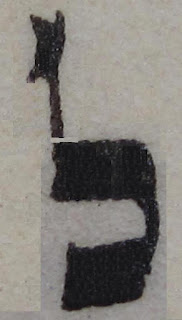lamed with a clear hefsek
I know there is a debate in the Acharonim as to may one fix this lamed in tefilin and mezuza.
My opinion is, that le'maase we can be meikal and fix [even shlo csidran].
My opinion is, that le'maase we can be meikal and fix [even shlo csidran].


RAV VOSNER WRITES IN A CASE OF SAFEK IF ITS NIKKAR LEHEDYA OR NOT WE CAN MAKE SFEK SFAIKA. BUT IF ITS A BIG NIFSEK (LEHEDYA LECHOL HADEOS) WE MUST BE MACHMIR.
ReplyDeleteThis hefsek is definitly nikar, I don't think this would be considered [in reality] a big hefsek though.
ReplyDeleteI maintain that according to the basic explanation of "hefsek nikar lehedya" [I wrote about this, in a post on this forum a while ago - have to search in archive when] this lamed may be connected/fixed although the hefsek [=the break] is nikar lehedya.
Sefer S'fakot Hasofer brings this exact example at lemed:19 and states that if it is nikar l'hedya then it pasul and can't be fixed as it is two letters and if not nikra l'hedya then would permit correction. Since this is a digitally altered photo with an artificial hefsek it is hard to properly conclude. However if it were a naturally occuring break with the result that there may well have been some tiny ink deposit/echo/fade remaining that was there previously I would have been meykel and corrected and it wouldn't be shelo k'sidran. Funnily enough a couple of years ago I saw a local rabbi stop reading, quickly roll up the Torah, march it to the aron, get another and unroll and start reading all in one very swift certain movement. Afterwards he told me that he came across a lamed where the entire vav head had NEVER been written there! Not even a residue of a fade.
ReplyDelete